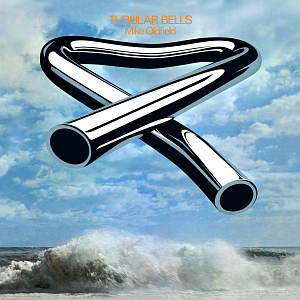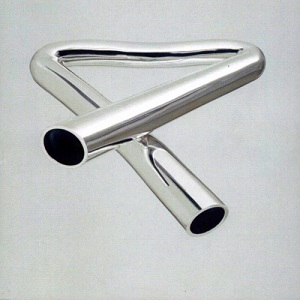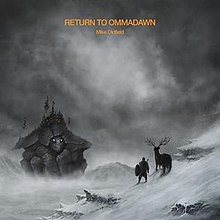
Michael Gordon Oldfield is an English musician, songwriter, and producer best known for his debut studio album Tubular Bells (1973), which became an unexpected critical and commercial success. Though primarily a guitarist, Oldfield plays a range of instruments, which includes keyboards, percussion, and vocals. He has adopted a range of musical styles throughout his career, including progressive rock, world, folk, classical, electronic, ambient, and new age music.

Tubular Bells is the debut studio album by the British musician Mike Oldfield, released on 25 May 1973 as the first album on Virgin Records. It comprises two mostly instrumental tracks. Oldfield, who was 19 years old when it was recorded, played almost all the instruments.

Tubular Bells II is the fifteenth studio album by English guitarist and songwriter Mike Oldfield. It was released on 31 August 1992 by Warner Music UK and is the successor to his debut album Tubular Bells (1973). After his contract with Virgin Records ended at the end of 1991, Oldfield signed with Warner and started work on a sequel to Tubular Bells. The album charted at number 1 in the UK as did its precursor. It is Oldfield's third number-one album.

Tubular Bells 2003 is the 22nd studio album by English musician Mike Oldfield, released on 27 May 2003 by Warner Music Spain. It is a digital re-recording of his 1973 album Tubular Bells, released almost 30 years earlier. To date, this is the most recent album in the Tubular Bells series.

Hergest Ridge is the second studio album by English musician and songwriter Mike Oldfield, released on 2 September 1974 by Virgin Records. The unexpected commercial and critical success of his debut album Tubular Bells (1973) affected Oldfield, who decided against touring and avoided the press with his newfound fame. Instead, he retreated to Hergest Ridge on the England–Wales border and wrote the follow-up, which he recorded in 1974 at The Manor in Oxfordshire, with Tom Newman returning as co-producer. Similar to Oldfield's first, the album is a single composition split into two parts covering different moods and musical styles.

Ommadawn is the third studio album by English musician, multi-instrumentalist and songwriter Mike Oldfield, released on 3 November 1975 on Virgin Records.

Incantations is the fourth studio album by English musician, songwriter, and producer Mike Oldfield, released on 1 December 1978 by Virgin Records. Following the release of his previous album Ommadawn (1975), Oldfield moved into a new home in Bisley, Gloucestershire, where he set up a new recording studio. He started on a follow-up in 1977 which took form as a double album with one, side-long track on each side of the LP record. Oldfield wished to use real incantations in the music, but ended up using folklore as a loose running theme, such as Dianna the Huntress. Though primarily instrumental, lyrical sections are adapted from works by poets Henry Longfellow and Ben Jonson. Oldfield completed the self-awareness seminar Exegesis while recording Incantations.

Platinum is the fifth studio album by English multi-instrumentalist and songwriter Mike Oldfield, released on 23 November 1979 on Virgin Records. It was Oldfield's first album to include shorter songs and music written by others. A modified version of the album was released in the United States and Canada and titled Airborn.

Amarok is the thirteenth studio album by English multi-instrumentalist and songwriter Mike Oldfield, released in May 1990 by Virgin Records. Oldfield originally conceived it as an "angry protest album", showcasing his musical technique. It is presented as a single sixty-minute track of continuous, uninterrupted but constantly changing music.

Five Miles Out is the seventh studio album by English recording artist Mike Oldfield, released on 19 March 1982 by Virgin Records in the UK. After touring in support of his previous album, QE2 (1980), ended in mid-1981, Oldfield started on a follow-up with members of his touring band performing the music. The album features the 24-minute track "Taurus II" on side one and four shorter songs on side two. The songs "Family Man" and "Orabidoo" are credited to Oldfield and members of his touring band which included vocalist Maggie Reilly, drummer Morris Pert, and guitarist Rick Fenn.

Discovery is the ninth studio album by English multi-instrumentalist and songwriter Mike Oldfield, released on 25 June 1984 on Virgin Records. It comprises a number of pop songs, most notably the single "To France", as well as the instrumental "The Lake".

Voyager is the 17th music album by Mike Oldfield, released in 1996 by Warner Music UK. It is a Celtic-themed album with new compositions intertwined with traditional pieces.

Tubular Bells III is the eighteenth studio album by English guitarist, songwriter, and producer Mike Oldfield. It was released on 31 August 1998 by Warner Music UK as the third instalment in his Tubular Bells album series. After relocating from England to the Spanish island of Ibiza in 1996, Oldfield started work on the album and gained inspiration to incorporate electronic music from the island's local bars and clubs.

Elements – The Best of Mike Oldfield is a compilation album by Mike Oldfield, released in 1993 by Virgin Records.

The Complete Mike Oldfield is a compilation album by Mike Oldfield, released on 21 October 1985 by Virgin Records in the UK.

The Orchestral Tubular Bells is an orchestral version of Mike Oldfield's album Tubular Bells, arranged by David Bedford and recorded in 1974 by the Royal Philharmonic Orchestra, featuring Oldfield himself playing the guitar. Excerpts from the album were featured in the 1979 NASA film, The Space Movie. It peaked at #17 on the UK Albums Chart in 1975.
This page is a discography for the musician Mike Oldfield.

Boxed is a 1976 compilation album of music written and performed by Mike Oldfield. It features four channel quadraphonic remix versions of his first three albums:Tubular Bells, Hergest Ridge and Ommadawn. An additional fourth LP contains new musical collaborations with other artists.

Music Wonderland is a compilation album by Mike Oldfield released in 1981 on Virgin Records. The album has since been reissued worldwide on CD.

Man on the Rocks is the twenty-fifth studio album by British musician Mike Oldfield, released on 3 March 2014 on the Virgin EMI label. The album is Oldfield's second full album of exclusively songs with no long or instrumental pieces, the first being 1989's Earth Moving.



















